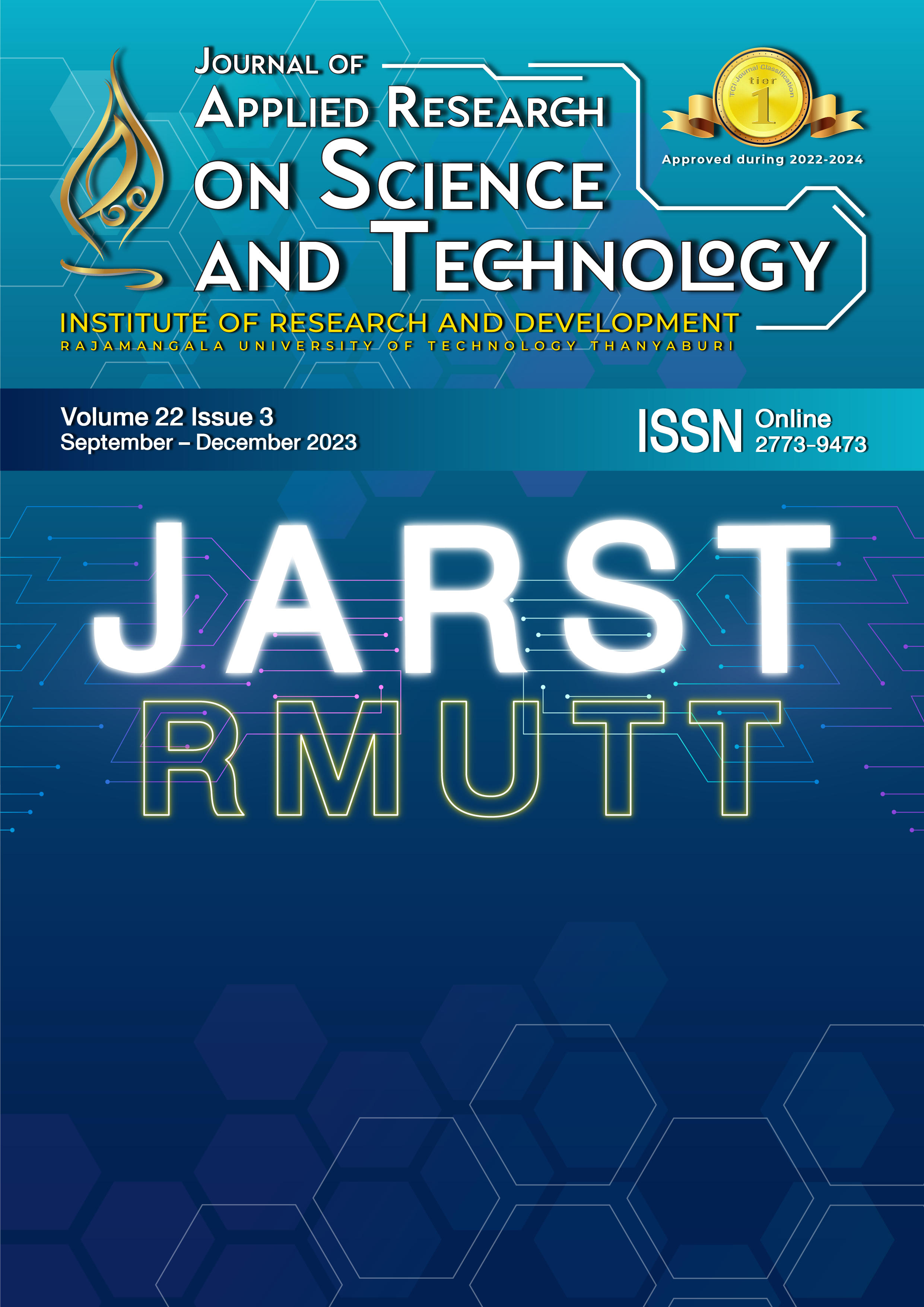Cellulose rubber foam composite use as oil absorbent
Main Article Content
Abstract
The focus of this study was to explore the fabrication of cellulose rubber foam (CRF) using kapok fibers (KF) as an oil absorbent material. Chemical methods such as sodium hydroxide surface treatment, hydrogen peroxide treatment, and acid hydrolysis were employed to prepare cellulose nanocrystals (CNC). The results of the nuclear magnetic resonance (NMR) spectroscopy test indicated that the chemical modification of kapok fiber resulted in the removal of lignin and hemicellulose by a disappearing peak at 17, 52, and 148 ppm, respectively. Hydrolysis process of the kapok fiber resulted in nanometer-sized cellulose, with a yield of 72% as revealed by transmission electron microscopy (TEM). The amount of cellulose nanocrystals from kapok fiber (KF-CNC) used in the study varied from 0 to 5 phr during the formation of the cellulose rubber foam, and it was found that the foam density increased as the number of cellulose nanocrystals from kapok fiber increased. Additionally, the percentage of collapse from the compressive strength of cellulose rubber foam decreased as the amount of cellulose nanocrystals from kapok fiber increased. Fourier transform infrared spectroscopy (FTIR) confirmed the incorporation of cellulose nanocrystals from kapok fiber into the rubber foam (RF) as the amount of cellulose nanocrystals from kapok fiber increased. The oil absorbent of cellulose rubber foam composite with 1 phr cellulose nanocrystals from kapok fiber show highest absorption capacity was 17.8 g/g. The cellulose rubber foam composite absorbs oil before absorbing water when water and oil are combined. Moreover, the cellulose rubber foam could be reused more than 50 times.
Article Details

This work is licensed under a Creative Commons Attribution-NonCommercial-NoDerivatives 4.0 International License.
References
Phomrak S, Nimpaiboon A, Newby B-mZ, Phisalaphong M. Natural rubber latex foam reinforced with micro-and nanofibrillated cellulose via Dunlop method. Polymers. 2020;12(9):1959.
Karim AFA, Ismail H, Ariff ZM. Properties and characterization of kenaf-filled natural rubber latex foam. BioResources. 2016;11(1):1080-91.
Kengkhetkit N, Amornsakchai T. Utilisation of pineapple leaf waste for plastic reinforcement: 1. A novel extraction method for short pineapple leaf fiber. Ind Crop Prod. 2012;40:55-61.
Dong T, Xu G, Wang F. Oil spill cleanup by structured natural sorbents made from cattail fibers. Ind Crop Prod. 2015;76:25-33.
Lee BM, Jeun JP, Kang PH, Choi JH, Hong SK. Isolation and characterization of nanocrystalline cellulose from different precursor materials. Fiber Polym. 2017;18:272-7.
Arnata IW, Suprihatin S, Fahma F, Richana N, Candra Sunarti T. Cellulose production from sago frond with alkaline delignification and bleaching on various types of bleach agents. Orient J Chem. 2019;35(1):8-19.
Pantamanatsopa P, Ariyawiriyanan W, Ekgasit S. Production of Cellulose Nanocrystals Suspension with High Yields from Water Hyacinth. J Nat Fibers. 2023;20(1):2134266.
395 AD. Standard test method for rubber property-compression set of vulcanized rubber. 1955.
Yuan Y, Shutov F. Foam-in-foam polyurethane composite. J Cell Plast. 2002;38(6):497-506.
726-12 Standard Test Method for Sorbent Performance of Adsorbents 2012. ASTM F, editor. ASTM Philadelphia.
Dilamian M, Noroozi B. Rice straw agri-waste for water pollutant adsorption: Relevant mesoporous super hydrophobic cellulose aerogel. Carbohydr Polym. 2021;251:117016.
Ratcha A, Samart C, Yoosuk B, Sawada H, Reubroycharoen P, Kongparakul S. Polyisoprene modified poly (alkyl acrylate) foam as oil sorbent material. J Appl Polym Sci. 2015;132(42).
Udayakumar KV, Gore PM, Kandasubramanian B. Foamed materials for oil-water separation. Chemical Engineering Journal Advances. 2021;5:100076.
Yousefian H, Rodrigue D. Morphological, physical and mechanical properties of nanocrystalline cellulose filled Nylon 6 foams. J Cell Plast. 2016;53(3):253-71.


